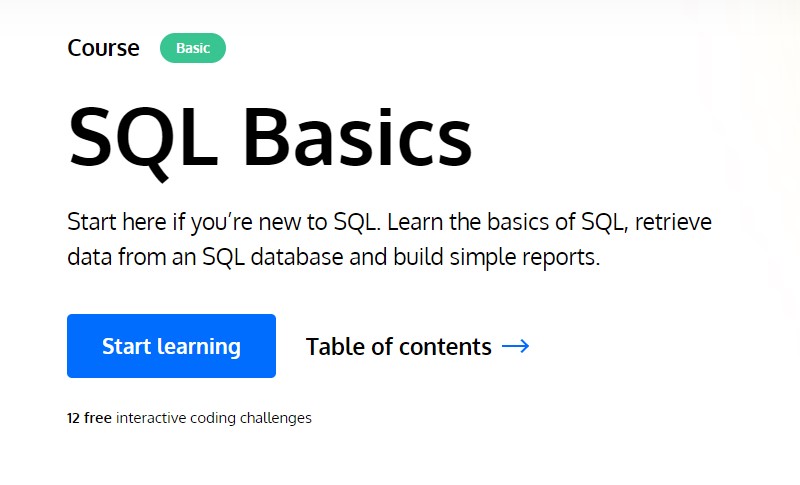SQL aggregate functions are your go-to tools for transforming raw data into actionable insights. They condense multiple rows into single, meaningful values, making it easier to grasp the big picture. Whether you're calculating total sales, average ratings, or the number of unique products, aggregate functions are indispensable for data analysis.
Let's explore these powerful functions and how they can revolutionize your SQL workflows.
Common Aggregate Functions

Here's a breakdown of some essential aggregate functions:
- SUM: Calculates the total sum of a column's values.
- AVG: Determines the average value within a column.
- COUNT: Counts the number of rows or distinct values.
- MIN: Retrieves the smallest value within a column.
- MAX: Extracts the largest value within a column.
New to SQL? No problem!
The SQL Basics course is your ideal starting point. With 129 interactive exercises, you'll gain confidence and practical skills in no time. Learn from anywhere, using your browser to access our online database – no software installation required.
Unleashing the Power of Aggregate Functions
Example 1: Calculate Total Revenue
This example demonstrates how to calculate the total revenue from all orders using the SUM function.
SELECT SUM(order_total) FROM orders;Example 2: Find Average Customer Rating
This example shows how to find the average customer rating using the AVG function.
SELECT AVG(rating) FROM customer_reviews;Example 3: Count Unique Products
This example illustrates how to count the number of unique products in your inventory using the COUNT(DISTINCT ...) function.
SELECT COUNT(DISTINCT product_id) FROM inventory;Example 4: Identify Lowest and Highest Prices
This example demonstrates how to use the MIN and MAX functions to find the lowest and highest product prices.
SELECT MIN(price), MAX(price) FROM products;GROUP BY: Aggregate by Category
The GROUP BY clause lets you calculate aggregate functions for specific groups or categories within your data.
Example 5: Total Sales by Region
This example calculates the total sales for each region by grouping the orders table by region and then summing the order_total.
SELECT region, SUM(order_total) FROM orders
GROUP BY region;Example 6: Average Salary by Department
This example calculates the average salary for each department by grouping the employees table by department and then averaging the salary.
SELECT department, AVG(salary) FROM employees
GROUP BY department;Beyond the Basics: Exploring More Aggregate Functions
SQL provides a rich set of aggregate functions beyond the common ones we've covered. These advanced functions allow you to delve deeper into your data and uncover nuanced patterns:
- STDEV: Measures the standard deviation, a statistical metric that quantifies the dispersion or spread of data values.
- VAR: Calculates the variance, another measure of data variability.
- COUNT_DISTINCT: Counts the number of unique, non-null values within a column, providing insight into the diversity of data.
- FIRST/LAST: Retrieves the first or last value based on a specified ordering, useful for time series or sequential data.
Example 7: Calculate Product Price Variation
This example helps you understand how much the prices of products within each category vary, revealing potential pricing inconsistencies or opportunities for optimization.
SELECT product_category, STDEV(price) AS price_std_dev, VAR(price) AS price_variance
FROM products
GROUP BY product_category;Example 8: Count Unique Customers per City
This query helps you understand the customer reach in different cities, identifying potential target markets.
SELECT city, COUNT(DISTINCT customer_id) AS unique_customers
FROM customers
GROUP BY city;Example 9: Find the First and Last Order Dates for Each Customer
This example is useful for tracking customer behavior over time, potentially identifying loyal customers or those who haven't made a purchase in a while.
SELECT customer_id, MIN(order_date) AS first_order, MAX(order_date) AS last_order
FROM orders
GROUP BY customer_id;These are just a few examples of how advanced aggregate functions can unlock valuable insights from your data. Experiment with them to discover hidden patterns and trends.
Wrapping Up
SQL aggregate functions are the backbone of data analysis. Whether you're a novice or a seasoned SQL pro, mastering these functions empowers you to extract meaningful insights from your data and make informed decisions.
Ready to Elevate Your SQL Skills?
LearnSQL offers interactive SQL courses tailored for all skill levels. Their SQL Practice learning path is a great place to start, with 9 comprehensive courses covering JOINs, aggregate functions, and more. You'll work with real-world datasets for hands-on practice. To stay ahead of the curve, check out their Monthly SQL Practice track for fresh content.
For the ultimate learning experience, consider the All Forever SQL Plan. You'll get lifetime access to all current and future courses, ensuring your SQL expertise stays up-to-date.
Embark on your SQL adventure today and unlock the power of data!
The post SQL Aggregate Functions: Your Essential Guide & Cheat Sheet appeared first on RealSQLGuy.


